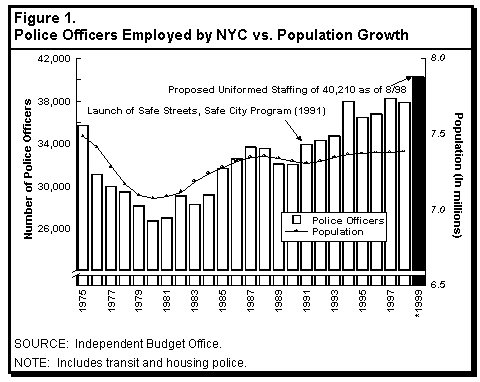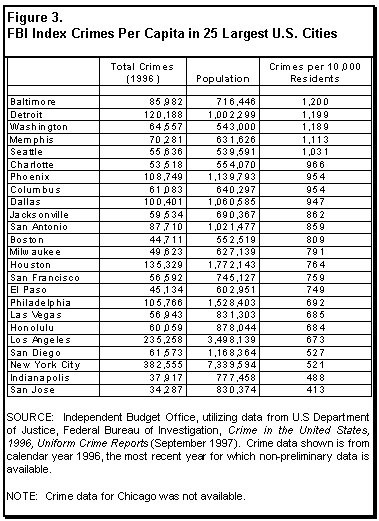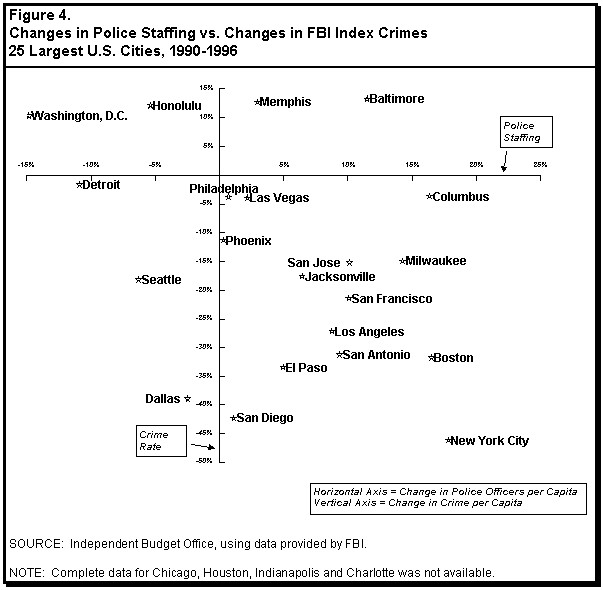

March 16, 1998
Police Staffing Levels and Reported Crime Rates in America’s
Largest Cities: Results of Preliminary Analysis
In March 1998, at the request of Councilmember Sheldon S. Leffler, Chairman of the City Council’s Public Safety Committee, the Independent Budget Office (IBO) conducted an analysis of police staffing levels and crime rates in the nation’s largest cities. In particular, IBO considered the extent to which a relationship exists between the two variables. We have expedited release of this preliminary analysis to assist Councilmember Leffler with his committee’s March 19th public hearing on the Police Department’s preliminary budget for 1999.
As shown in Figure 1, uniformed police staffing in New York City has grown by about 6,000 police officers in the 1990s, primarily as a result of the Safe Streets, Safe City initiative. The Mayor’s preliminary budget for 1999 proposes further expanding NYPD uniformed staffing by 1,600 police officers, to an all-time high of 40,210 by August 1998. The cost of hiring and retaining the additional police officers would be partially covered by federal funding made available through the Justice Department’s Community Oriented Policing Services (COPS) program. More specifically, the Mayor’s financial plan calls for funding the additional officers by combining COPS funds with about $21 million annually in city taxpayer dollars from 1999 through 2001. The Mayor’s plan assumes expiration of the COPS program funding in 2002, thereby necessitating full city funding for the additional officers at an annual cost of about $66 million.

Police staffing levels in America’s 25 largest cities
As shown in Figure 2, New York City (with 53 police officers per 10,000 residents) is currently second only to Washington among the nation’s 25 most populous cities in terms of police officers per capita, with the average ratio in the other cities at 29 police officers per 10,000 residents. If the Mayor’s proposal is adopted and NYPD expands to 40,210 uniformed personnel, New York City would have 55 police officers per 10,000 residents, almost double the average in America’s next 24 largest cities. (Note: IBO is aware of the fact that when gauging police coverage in a given city, the number of police officers actually engaged in direct law enforcement activities, often referred to as patrol strength, is in many ways a more meaningful measure than the total number of officers on the payroll. However, given that patrol strength is not defined consistently from city to city, we focus in this analysis on per capita police staffing.)

Reported crime in America’s 25 largest cities
New York City’s recent reductions in crime have resulted in the city having one of the lowest crime rates in the country among large cities. More specifically, as shown in Figure 3, New York City now has a lower crime rate than all but two of the nation’s 25 most populous cities. (References to crime in this report pertain to FBI Index Crimes, comprising murder and non-negligent manslaughter, robbery, forcible rape, aggravated assault, burglary, larceny theft, and motor vehicle theft.)

Empirical connections between police staffing levels and rates of reported crime
Clearly, crime has been going down in the 1990s in New York City while the number of police officers has gone up. What is less clear, however, is the precise relationship between the two trends. That is, has crime fallen primarily because of rising police staffing levels, more effective deployment of police resources, or some combination of the two? To what extent have factors such as demographic shifts, alterations in drug consumption patterns, rising rates of incarceration of offenders, or some combination of these and perhaps other factors contributed to the declines in reported crime? These questions continue to be the focal point of vigorous debate.
With respect to empirically demonstrated connections between police staffing levels and rates of reported crime, there seems to be no clear consensus among the academic community. For example, Professor Lawrence W. Sherman from the University of Maryland recently indicated that most of the studies that have been done on the effect of police staffing levels on reported crime are "scientifically weak."
On a very basic level, however, a review of the data in Figures 2 and 3 reveals the fact that police staffing is obviously not the only factor influencing crime rates. Most notably, the two major cities with lower crime rates than New York, as shown at the bottom of Figure 3, also occupy the bottom two positions within Figure 2. In other words, Indianapolis and San Jose have the lowest crime rates among the nation’s 25 largest cities, despite the fact that they are also the least heavily staffed in terms of police personnel per capita.

Further analysis of data we have gathered to date is shown in Figure 4, which graphically compares changes in police force size and crime rates from 1990 to 1996. Notable highlights include:
à Most dramatically, Dallas enjoyed a 39 percent drop in its crime rate, despite the fact that the number of police officers per capita in Dallas actually declined by between 2 percent and 3 percent.
à Meanwhile, Seattle experienced an 18 percent drop in its crime rate despite a decline of 6 percent in the number of police officers per capita.
The Independent Budget Office is continuing its analysis of this matter. IBO’s lead analyst on police issues is Bernard O’Brien, Senior Budget and Policy Analyst, at (212) 442-8656.